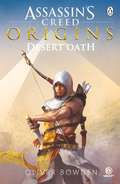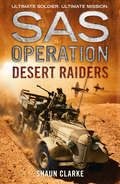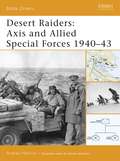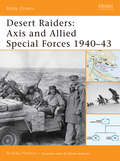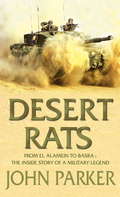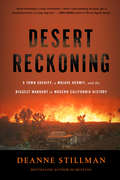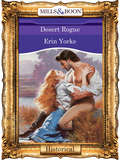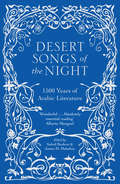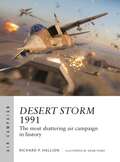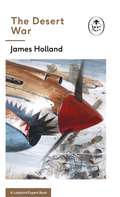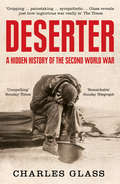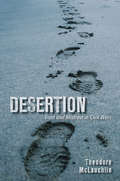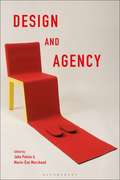- Table View
- List View
The Desert Nurse: A Grand Love Story Set In A Theatre Of War
by Pamela HartA grand love story set in a far-flung theatre of war, from the bestselling Australian author of The War Bride, Pamela HartAmid the Australian Army hospitals of World War I Egypt, two deeply determined individuals find the resilience of their love tested to its limits . . . It's 1911, and 21-year-old Evelyn Northey desperately wants to become a doctor. Her father forbids it, withholding the inheritance that would allow her to attend university. At the outbreak of World War I, Evelyn disobeys her father, enlisting as an army nurse bound for Egypt and the disastrous Gallipoli campaign.Under the blazing desert sun, Evelyn develops feelings for polio survivor Dr William Brent, who believes his disability makes him unfit to marry. For Evelyn, still pursuing her goal of studying medicine, a man has no place in her future. For two such self-reliant people, relying on someone else for happiness may be the hardest challenge of all . . .From the casualty tents, the fever wards and the operating theatres of the palace; through the streets of Cairo during Ramadan, to the parched desert and the grim realities of war, Pamela Hart, beloved bestselling Australian author of The War Bride, tells the heart-wrenching story of four years that changed the world forever.Praise for Pamela Hart'This book is heart-wrenching proof that all's NOT fair in love and war, especially for a lone woman in a man's world.' Valerie Parv on A Letter From Italy'Evokes WWI Sydney to the point where the reader can almost feel the salty wind blowing off the harbour as the troops are shipped out through the Heads' Books + Publishing on The Soldier's Wife'A Letter From Italy cements Pamela Hart as a go-to author when I want a love story to remember' Ausrom Today
Desert Oath: The Official Prequel to Assassin’s Creed Origins
by Oliver BowdenTHE LATEST in the Assassin's Creed series . . . Travel further back in time than ever before . . . Discover an ancient Egypt on the brink of collapse, and meet the characters in the official prequel to the latest instalment of the bestselling Assassin's Creed video game series.Before Assassin's Creed Origins, there was an Oath.Egypt, 70BC, a merciless killer stalks the land. His mission: to find and destroy the last members of an ancient order, the Medjay - to eradicate the bloodline.In peaceful Siwa, the town's protector abruptly departs, leaving his teenage son, Bayek, with questions about his own future and a sense of purpose he knows he must fulfill. Bayek sets off in search of answers, his journey taking him along the Nile and through an Egypt in turmoil, facing the dangers and the mysteries of the Medjay's path.
Desert Queen: The Extraordinary Life Of Gertrude Bell: Adventurer, Adviser To Kings, Ally Of Lawrence Of Arabia
by Janet WallachThe life of Gertrude Bell is now the subject of the major motion picture Queen of the Desert, starring Nicole Kidman, James Franco and Damian LewisTurning away from privileged Victorian Britain, Gertrude Bell explored, mapped and excavated the world of the Arabs, winning the trust of Arab sheiks and chieftains along the way. When the First World War erupted and the British needed the loyalty of Arab leaders, Gertrude Bell provided the intelligence for T.E. Lawrence's military activities. After the war, she played a major role in creating the modern Middle East, and was generally considered the most powerful woman in the British Empire.In this major reassessment of Bell's life, Janet Wallach reveals a woman whose achievements and independent spirit were especially remarkable for her times, and who brought the same passion and intensity to her explorations as she did to her rich and romantic life.
Desert Raiders (SAS Operation)
by Shaun ClarkeUltimate soldier. Ultimate mission. But can the SAS face the might of Rommel’s army and win?
Desert Raiders: Axis and Allied Special Forces 1940–43 (Battle Orders)
by Andrea MolinariAlthough harsh and inhospitable, the North African theatre of World War II proved to be a perfect environment for irregular warfare and the deployment of Special Forces. Following Italy's entry into the war in June 1940, the Western Desert became the background for a long conflict dominated by motorized units. The major combatants Great Britain, Free France, Italy and Germany all developed irregular units to exploit the unique conditions of the region with varying degrees of success. This book details the genesis, organization and tactics of these forces, including such famous units as the Long Range Desert Group and the Special Air Service.
Desert Raiders: Axis and Allied Special Forces 1940–43 (Battle Orders #23)
by Andrea MolinariAlthough harsh and inhospitable, the North African theatre of World War II proved to be a perfect environment for irregular warfare and the deployment of Special Forces. Following Italy's entry into the war in June 1940, the Western Desert became the background for a long conflict dominated by motorized units. The major combatants Great Britain, Free France, Italy and Germany all developed irregular units to exploit the unique conditions of the region with varying degrees of success. This book details the genesis, organization and tactics of these forces, including such famous units as the Long Range Desert Group and the Special Air Service.
Desert Rats: From El Alamein To Basra - The Inside Story Of A Military Legend
by John ParkerIn the recent war in Iraq, the 7th Armoured Brigade, bearers of the Desert Rats insignia, was immediately engaged in some of the fiercest early fighting, ultimately taking Basra for the Allies. The war in Iraq revived public focus on the Desert Rats whose famous battles of World War II helped turn the tide of German dominance. After World War II the Desert Rats re-emerged as part of the NATO forces during the Cold War years, and in other major deployments in the 1991 Gulf War, Bosnia and Kosovo. In this latest of his military histories, John Parker once again draws heavily on the drama of first-hand accounts for a story that is a seminal part of modern military history.
Desert Reckoning: A Town Sheriff, a Mojave Hermit, and the Biggest Manhunt in Modern California History
by Deanne StillmanNorth of Los Angeles - the studios, the beaches, Rodeo Drive - lies a sparsely populated region that comprises fully one half of Los Angeles County. Sprawling across 2200 miles, this shadow side of Los Angeles is in the high Mojave Desert. Known as the Antelope Valley, it's a terrain of savage dignity, a vast amphitheatre of startling wonders that put on a show as the megalopolis burrows northward into the region's last frontier. Ranchers, cowboys, dreamers, dropouts, bikers, hikers, and felons have settled here - those who have chosen solitude over the trappings of contemporary life or simply have nowhere else to go. But in recent years their lives have been encroached upon by the creeping spread of subdivisions, funded by the once easy money of subprime America. McMansions - many empty now - gradually replaced Joshua trees; the desert - America's escape hatch - began to vanish as it became home to a latter-day exodus of pilgrims.It is against the backdrop of these two competing visions of land and space that Donald Kueck - a desert hermit who loved animals and hated civilization - took his last stand, gunning down beloved deputy sheriff Steven Sorensen when he approached his trailer at high noon on a scorching summer day. As the sound of rifle fire echoed across the Mojave, Kueck took off into the desert he knew so well, kicking off the biggest manhunt in modern California history until he was finally killed in a Wagnerian firestorm under a full moon as nuns at a nearby convent watched and prayed.This manhunt was the subject of a widely praised article by Deanne Stillman, first published in Rolling Stone, a finalist for a PEN Center USA journalism award, and included in the anthology Best American Crime Writing 2006. In Desert Reckoning she continues her desert beat and uses Kueck's story as a point of departure to further explore our relationship to place and the wars that are playing out on our homeland. In addition, Stillman also delves into the hidden history of Los Angeles County, and traces the paths of two men on a collision course that could only end in the modern Wild West. Why did a brilliant, self-taught rocket scientist who just wanted to be left alone go off the rails when a cop showed up? What role did the California prison system play in this drama? What happens to people when the American dream is stripped away? And what is it like for the men who are sworn to protect and serve?
Desert Rogue (Mills And Boon Vintage 90s Modern Ser.)
by Erin YorkeVictoria Shaw To the jaded eyes of adventurer Jed Kincaid, Victoria seemed nothing more than a pampered English rose. But in the heat of the desert sun, she was beginning to blossom into a vibrant woman with an untutored passion for life. Jed Kincaid Rogue. Maverick. Loner. Jed Kincaid was certainly no gentleman.
Desert Songs of the Night: 1500 Years of Arabic Literature
by Suheil Bushrui James M. MalarkeyA unique and extraordinary collection, Desert Songs of the Night presents some of the finest poetry and prose by Arab writers, from the Arab East to Andalusia, over the last 1,500 years. From the mystical imagery of the Qur'an and the colourful stories of The Thousand and One Nights, to the powerful verses of longing of Mahmoud Darwish and Nazik al-Mala'ika, this captivating collection includes translated excerpts of works by the major authors of the period, as well as by lesser known writers of equal significance. Desert Songs of the Night showcases the vibrant and distinctive literary heritage of the Arabs. Beautifully produced, this is the ideal book for lovers of world literature and for those who seek an acquaintance with gems of Arab thought and expression. 'Desert Songs of the Night is a wonderful introduction to fifteen centuries of a literature still largely unknown in the West, without which much of our civilizations would not have developed as they have, from the rediscovery of Aristotle by Arab commentators to the lyric poetry of Europe, from the magical world of the Arabian Nights to the modern revolutionary poets of Palestine. Absolutely essential reading for our troubled times.' Alberto Manguel 'At a time when the world is obsessing about violence and bloodletting in the Arab world, this remarkable anthology, which spans 1,500 years of Arab literary genius, is a stark reminder of the untold story we keep missing about the region.' Hanan al-Shaykh
Desert Storm 1991: The most shattering air campaign in history (Air Campaign)
by Richard P. HallionAn expertly written, illustrated new analysis of the Desert Storm air campaign fought against Saddam Hussein's Iraq, which shattered the world's fourth-largest army and sixth-largest air force in just 39 days, and revolutionized the world's ideas about modern air power.Operation Desert Storm took just over six weeks to destroy Saddam Hussein's war machine: a 39-day air campaign followed by a four-day ground assault. It shattered what had been the world's fourth-largest army and sixth-largest air force, and overturned conventional military assumptions about the effectiveness and value of air power.In this book, Richard P. Hallion, one of the world's foremost experts on air warfare, explains why Desert Storm was a revolutionary victory, a war won with no single climatic battle. Instead, victory came thanks largely to a rigorously planned air campaign. It began with an opening night that smashed Iraq's advanced air defense system, and allowed systematic follow-on strikes to savage its military infrastructure and field capabilities. When the Coalition tanks finally rolled into Iraq, it was less an assault than an occupation.The rapid victory in Desert Storm, which surprised many observers, led to widespread military reform as the world saw the new capabilities of precision air power, and it ushered in today's era of high-tech air warfare.
The Desert War: Book 4 of the Ladybird Expert History of the Second World War (The Ladybird Expert Series)
by James Holland Keith BurnsPart of the ALL-NEW LADYBIRD EXPERT SERIES.____________Why was North Africa such a key component in Britain's success over Mussolini and his Italian Army?How did they blunt Italy's actions?What challenges did they face?And what new technologies were brought to bear?When fascist dictator Mussolini declared war against Britain he was taking a huge risk . . . Italy lacked natural resources, and Britain and France's wealth.He hoped to create a new Roman Empire across the Mediterranean and into Africa. And with Hitler and the Nazi's by his side he had a great chance of doing so - but what was it that stopped him?Discover the answers and more inside James Holland's The Desert War, the thrilling and accessible account that explains what happened, who the key figures were and the tactics, triumphs and failures on both sides . . .
The Deserted Bride (Mills And Boon Historical Ser.)
by Paula MarshallBess was a girl when she first saw her husband on their wedding day. Andrew, Earl of Exford, left after the ceremony, and as Bess blossomed into a lovely woman, she reveled in the freedom afforded by her absent spouse. Yet she knew the day would come when she would come face-to-face with her long-estranged husband.…
Deserter: The Last Untold Story Of The Second World War
by Charles GlassThe extraordinary story of the deserters of the Second World War. Who were they? What made them run? And what happened once they made the decision to flee?
Desertion: By the winner of the Nobel Prize in Literature 2021
by Abdulrazak Gurnah**By the winner of the Nobel Prize in Literature 2021**'A careful and heartfelt exploration of the way memory inevitably consoles and disappoints us' Sunday Times 'Beautifully written and pleasurable ... The work of a maestro' Guardian'An absorbing novel about abandonment and loss' Daily Telegraph___________________________________Early one morning in 1899, in a small town along the coast from Mombasa, Hassanali sets out for the mosque. But he never gets there, for out of the desert stumbles an ashen and exhausted Englishman who collapses at his feet. That man is Martin Pearce - writer, traveller and something of an Orientalist. After Pearce has recuperated, he visits Hassanali to thank him for his rescue and meets Hassanali's sister Rehana; he is immediately captivated. In this crumbling town on the edge of civilised life, with the empire on the brink of a new century, a passionate love affair begins that brings two cultures together and which will reverberate through three generations and across continents.
Desertion: By the winner of the Nobel Prize in Literature 2021
by Abdulrazak Gurnah**By the winner of the Nobel Prize in Literature 2021**'A careful and heartfelt exploration of the way memory inevitably consoles and disappoints us' Sunday Times 'Beautifully written and pleasurable ... The work of a maestro' Guardian'An absorbing novel about abandonment and loss' Daily Telegraph___________________________________Early one morning in 1899, in a small town along the coast from Mombasa, Hassanali sets out for the mosque. But he never gets there, for out of the desert stumbles an ashen and exhausted Englishman who collapses at his feet. That man is Martin Pearce - writer, traveller and something of an Orientalist. After Pearce has recuperated, he visits Hassanali to thank him for his rescue and meets Hassanali's sister Rehana; he is immediately captivated. In this crumbling town on the edge of civilised life, with the empire on the brink of a new century, a passionate love affair begins that brings two cultures together and which will reverberate through three generations and across continents.
Desertion: Trust and Mistrust in Civil Wars
by Theodore McLauchlinTheodore McLauchlin's Desertion examines the personal and political factors behind soldiers' choices to stay in their unit or abandon their cause. He explores what might spur widespread desertion in a given group, how some armed groups manage to keep their soldiers fighting over long periods, and how committed soldiers are to their causes and their comrades.To answer these questions, McLauchlin focuses on combatants in military units during the Spanish Civil War. He pushes against the preconception that individual soldiers' motivations are either personal or political, either selfish or ideological. Instead, he draws together the personal and the political, showing how soldiers come to trust each other—or not. Desertion demonstrates how the armed groups that hold together and survive are those that foster interpersonal connections, allowing soldiers the opportunity to prove their commitment to the fight.McLauchlin argues that trust keeps soldiers in the fray, mistrust pushes them to leave, and political beliefs and military practices shape both. Desertion brings the reader into the world of soldiers and rigorously tests the factors underlying desertion. It asks, honestly and without judgment, what would you do in an army in a civil war? Would you stand and fight? Would you try to run away? And what if you found yourself fighting for a cause you no longer believe in or never did in the first place?
Desertion in the Early Modern World: A Comparative History
by Matthias Van Rossum Jeannette KampEarly modern globalization was built on a highly labour intensive infrastructure. This book looks at the millions of workers who were needed to operate the ships, ports, store houses, forts and factories crucial to local and global exchange. These sailors, soldiers, craftsmen and slaves were crucial to globalization but were also confronted with the process of globalization themselves. They were often migrants who worked, directly or indirectly, for trading companies, merchants and producers that tried to discipline and control their labour force.The contributors to this volume offer an integrated, thematic study of the global history of desertion in European, Atlantic and Asian contexts. By tracing and comparing acts and patterns of desertion across empires, economic systems, regions and types of workers, Desertion in the Early Modern World illuminates the crucial role of practices of desertion among workers in shaping the history of imperial and economic expansion in the early modern period.
Desertion in the Early Modern World: A Comparative History
by Matthias Van Rossum Jeannette KampEarly modern globalization was built on a highly labour intensive infrastructure. This book looks at the millions of workers who were needed to operate the ships, ports, store houses, forts and factories crucial to local and global exchange. These sailors, soldiers, craftsmen and slaves were crucial to globalization but were also confronted with the process of globalization themselves. They were often migrants who worked, directly or indirectly, for trading companies, merchants and producers that tried to discipline and control their labour force.The contributors to this volume offer an integrated, thematic study of the global history of desertion in European, Atlantic and Asian contexts. By tracing and comparing acts and patterns of desertion across empires, economic systems, regions and types of workers, Desertion in the Early Modern World illuminates the crucial role of practices of desertion among workers in shaping the history of imperial and economic expansion in the early modern period.
The Desertmakers: Travel, War, and the State in Latin America (Routledge Research in Travel Writing)
by Javier UriarteThis book studies how the rhetoric of travel introduces different conceptualizations of space and time in scenarios of war during the last decades of the 19th century, in Argentina, Brazil, Paraguay, and Uruguay. By examining accounts of war and travel in the context of the consolidation of state apparatuses in these countries, Uriarte underlines the essential role that war (in connection to empire and capital) has played in the Latin American process of modernization and state formation. In this book, the analysis of British and Latin American travel narratives proves particularly productive in reading the ways in which national spaces are reconfigured, reimagined, and reappropriated by the state apparatus. War turns out to be a central instrument not just for making possible this logic of appropriation, but also for bringing temporal notions such as modernization and progress to spaces that were described — albeit problematically — as being outside of history. The book argues that wars waged against "deserts" (as Patagonia, the sertão, Paraguay, and the Uruguayan countryside were described and imagined) were in fact means of generating empty spaces, real voids that were the condition for new foundations. The study of travel writing is an essential tool for understanding the transformations of space brought by war, and for analyzing in detail the forms and connotations of movement in connection to violence. Uriarte pays particular attention to the effects that witnessing war had on the traveler’s identity and on the relation that is established with the oikos or point of departure of their own voyage. Written at the intersection of literary analysis, critical geography, political science, and history, this book will be of interest to those studying Latin American literature, Travel Writing, and neocolonialism and Empire writing.
The Desertmakers: Travel, War, and the State in Latin America (Routledge Research in Travel Writing)
by Javier UriarteThis book studies how the rhetoric of travel introduces different conceptualizations of space and time in scenarios of war during the last decades of the 19th century, in Argentina, Brazil, Paraguay, and Uruguay. By examining accounts of war and travel in the context of the consolidation of state apparatuses in these countries, Uriarte underlines the essential role that war (in connection to empire and capital) has played in the Latin American process of modernization and state formation. In this book, the analysis of British and Latin American travel narratives proves particularly productive in reading the ways in which national spaces are reconfigured, reimagined, and reappropriated by the state apparatus. War turns out to be a central instrument not just for making possible this logic of appropriation, but also for bringing temporal notions such as modernization and progress to spaces that were described — albeit problematically — as being outside of history. The book argues that wars waged against "deserts" (as Patagonia, the sertão, Paraguay, and the Uruguayan countryside were described and imagined) were in fact means of generating empty spaces, real voids that were the condition for new foundations. The study of travel writing is an essential tool for understanding the transformations of space brought by war, and for analyzing in detail the forms and connotations of movement in connection to violence. Uriarte pays particular attention to the effects that witnessing war had on the traveler’s identity and on the relation that is established with the oikos or point of departure of their own voyage. Written at the intersection of literary analysis, critical geography, political science, and history, this book will be of interest to those studying Latin American literature, Travel Writing, and neocolonialism and Empire writing.
Design: The Key Concepts (The Key Concepts)
by D.J. HuppatzDesign is everywhere. It shapes not only our present but also our future. An essential introductory guide, Design: The Key Concepts covers fundamental design concepts: thinking, service, context, interaction, experience, and systems.Each concept is situated within a broad context, enabling the reader to understand design's contemporary practice and its relationship to issues such as new technology, social and economic development, globalization, and sustainability. Concepts are also explained by use of concise, illustrated case studies of contemporary objects, spaces, systems, and methods such as Uber, the iPhone, Kickstarter and IKEA. Chapter summaries and supporting discussion questions make this an engaging and accessible introduction for students and those new to the field. An annotated bibliography provides direction for further reading.
Design: The Key Concepts (The Key Concepts)
by D.J. HuppatzDesign is everywhere. It shapes not only our present but also our future. An essential introductory guide, Design: The Key Concepts covers fundamental design concepts: thinking, service, context, interaction, experience, and systems.Each concept is situated within a broad context, enabling the reader to understand design's contemporary practice and its relationship to issues such as new technology, social and economic development, globalization, and sustainability. Concepts are also explained by use of concise, illustrated case studies of contemporary objects, spaces, systems, and methods such as Uber, the iPhone, Kickstarter and IKEA. Chapter summaries and supporting discussion questions make this an engaging and accessible introduction for students and those new to the field. An annotated bibliography provides direction for further reading.
Design and Agency: Critical Perspectives on Identities, Histories, and Practices
by John Potvinand Marie-Ève MarchandDesign and Agency brings together leading international design scholars and practitioners to address the concept of agency in relation to objects, organisations and people. The authors set out to expand the scope of design history and practice, avoiding the heroic narratives of a typical modernist approach. They consider both how the agents of design construct and express their identities and subjectivities through practice, while also investigating the distinctive contribution of design in the construction of individual identity and subjectivity. Individual chapters explore notions of agency in a range of design disciplines and historical periods, including the agency of women in effecting changes to the design of offices and working practices; the role of Jeffrey Lindsay and Buckminster Fuller in developing the design of a geodesic dome; Le Corbusier's 'Casa Curutchet'; a re-consideration of the gendered historiography of the 'Jugendstil' movement, and Bruce Mau's design exhibitions. Taken together, the essays in Design and Agency provide a much-needed response to the traditional texts which dominate design history. With a broad chronological span from 1900 to the present, and an equally broad understanding of the term 'design', it expands how we view the discipline, and shows how design itself can be an agent for social, cultural and economic change.
Design and Agency: Critical Perspectives on Identities, Histories, and Practices
Design and Agency brings together leading international design scholars and practitioners to address the concept of agency in relation to objects, organisations and people. The authors set out to expand the scope of design history and practice, avoiding the heroic narratives of a typical modernist approach. They consider both how the agents of design construct and express their identities and subjectivities through practice, while also investigating the distinctive contribution of design in the construction of individual identity and subjectivity. Individual chapters explore notions of agency in a range of design disciplines and historical periods, including the agency of women in effecting changes to the design of offices and working practices; the role of Jeffrey Lindsay and Buckminster Fuller in developing the design of a geodesic dome; Le Corbusier's 'Casa Curutchet'; a re-consideration of the gendered historiography of the 'Jugendstil' movement, and Bruce Mau's design exhibitions. Taken together, the essays in Design and Agency provide a much-needed response to the traditional texts which dominate design history. With a broad chronological span from 1900 to the present, and an equally broad understanding of the term 'design', it expands how we view the discipline, and shows how design itself can be an agent for social, cultural and economic change.

